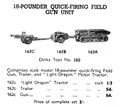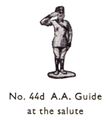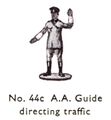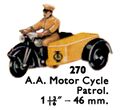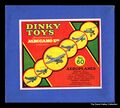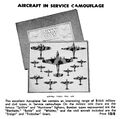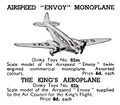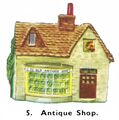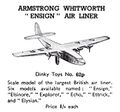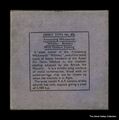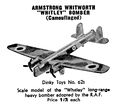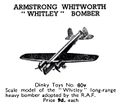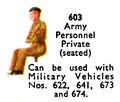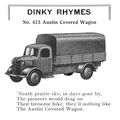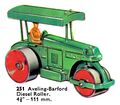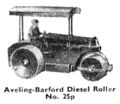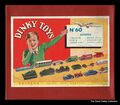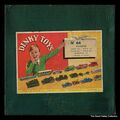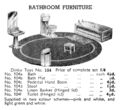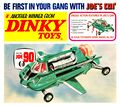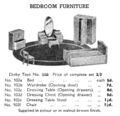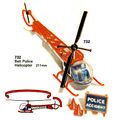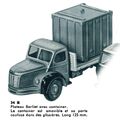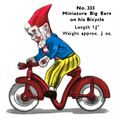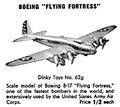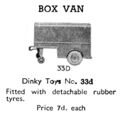Category:Diecast metal toys
The diecasting process involves injecting molten metal (usually a zinc-based alloy) into a mould made from hardened (usually tool-grade) steel. Diecasting became a significant feature of British toymaking with the introduction of Dinky Toys in the mid-1930s, cast using the recently-developed Mazac zinc alloy.
Advantages
- High casting pressures allow high detail
- High casting pressures allow the use of "sludgy" metal alloys
Limitations
Diecasting has certain limitations:
- The use of tool-grade steel makes the dies very expensive, so the process is most suitable for the mass-production if large numbers of identical parts - if making huge numbers of a piece, the initial cost of the die becomes less important. This makes diecasting very much an "industrial" process.
- There is typically a maximum size that can be cast per "shot", which limits the size of parts, and also the number of smaller parts that can be cast per "shot".
- The shapes of parts need to be reasonably simple to make it easy for the cast pieces to detach from the mould
- The process usually results in tiny amount of trapped air inside the final piece ("porosity"), which prevents further heat-treating processes (such as case-hardening) being applied to the parts, as this would encourage the tiny pockets of air to expand and form micro-cracks in the metal.
Some manufacturers had early problems with the disintegration of zinc alloy diecast items ("Zinc pest") caused by additional "foreign" metals ending up in the alloy before casting ... but these were solved by improved quality control.
Process characteristics
Diecasting usually involves non-ferrous metals, to limit metal migration between the melt and the tooling.
Diecasting usually involves the use of channels in the die to guide the liquid metal to the cavities for multiple parts, which then energe connected together by "sprues" or "runners" similar to those found in injection-moulded plastic model kits (eg traditional Airfix kits). In a variant called heated-manifold direct-injection die casting, the die has separate heated inlet nozzles for each chamber in the die, which reduces the amount of waste metal.
The properties make diecasting ideal for the production of smallish "chunky" toy vehicle bodies, where the castings don't have to have any particularly demanding properties, other than the ability to hold high levels of detail, to support thinnish window-frame details, to be able to hold springy steel axles, and to be able to be thudded repeatedly into furniture without cracking.
Alternatives
Lead
Prior to the appearance of diecasting, British cast metal toy vehicles were typically made from lead. Lead casting was a well-understood process but resulted in soft castings that might have trouble coping with being stood on, and had "weak" detailing – window frames and bumpers were prone to bending and breaking, wheels were prone to bucking and bending. The softness of the body metal meant that special care was needed when designing how wheels attached to springy steel axles, and how the axles attached to the body.
Ferrous metals
In the United States, some manufacturers of early metal toys in the late C19th and early C20th used cast iron as a material (eg for the bodies of toy railway locomotives).
This was again a known ("low-tech") material, but resulted in toys that were very heavy, somewhat crude and clunky, and had a tendency to break if dropped onto a hard surface, due to the brittleness of the material
White metal
For very small production runs, smaller companies might use "white metal" casting. This typically involves using very low melting-point metals and gravity-fed (or centrifugally fed mould made from special vulcanised rubber). White metal casting was typically only used by specialist "one-man" manufacturers producing low production run products such as niche metal kits.
The rubber moulds are far cheaper to make, but have very restricted lifespans: once a "cottage industry"'s products become popular it often becomes worth the company migrating their designs to diecasting (or plastic injection moulding).
Plastic injection moulding
After World War Two, the injection moulding of plastics became popular for lightweight toys where strength wasn't an issue.
Evolution
The production of small cast lead figures typically migrated from lead to plastic, as the additional strength of diecast alloys wasn't needed. Diecasting is still popular for small robust toy vehicles, and for larger vehicle models where some detailing may be plastic, but the rigid bodyshell uses diecast metal, typically painted to take a high-gloss finish.
Modern diecast toy vehicles typically also incorporate a variety of plastic parts, for windows (where transparency can't be recreated in metal), for seating and upholstery (where the soft appearance of plastic can add realism), and for fine protruding complex details. Moulded windscreen wipers flex when made from plastic where a metal casting would tend to break off at the root, and complex three-dimensional radiator grilles can often be injection-moulded in plastic and successfully extracted from the moulds due to plastic's flexibility, where an attempt to make the same shape in metal would result int the part and its mould ending up locked together.
Subcategories
This category has the following 58 subcategories, out of 58 total.
1
- 100 Years of Southdown (display) (11 P, 13 F)
2
- 25-Pounder Field Gun Set (Dinky Toys 697) (3 P, 2 F)
A
- Aeroplane Set (Dinky Toys 64) (empty)
- Aeroplane Set (Dinky Toys 65) (1 P, 1 F)
- Arkitex (11 P, 36 F)
B
- Benbros (2 F)
- British Aeroplanes (Dinky Toys 60) (6 P, 8 F)
- British Toy Racing Cars (display) (empty)
- Budgie Miniatures (12 F)
C
- Camouflaged Aeroplane Set (Dinky Toys 66) (4 P, 8 F)
- Chipperfields Circus (4 P, 3 F)
- Cotswold Village Series (15 F)
D
- Dinky Supertoys (14 P, 105 F)
- Dollhouse furniture, Bathroom (Dinky Toys 104) (4 P, 6 F)
- Dolly Varden dollhouse (5 F)
E
- ESSEM Series (1 P, 2 F)
- ESSO Series (4 F)
F
- French Aeroplanes (Dinky Toys 60z) (1 P, 1 F)
- French Aeroplanes (Dinky Toys 61z) (1 P, 1 F)
H
- Hot Wheels (25 F)
J
- Jennys Home room box system (4 P, 23 F)
M
- Matchbox Major (5 P, 4 F)
- Mazak (1 P, 1 F)
- Mobile Anti-Aircraft Unit (Dinky Toys 161) (1 P, 2 F)
- Mobile Vehicle Series (1 F)
N
O
- Old Crocks Miniature Series (empty)
R
- RAF Aeroplane Set (Dinky Toys 61) (1 P, 1 F)
- Royal Tank Corps Light Tank Set (Dinky Toys 152) (2 P, 2 F)
S
- Spot-On dollhouse fittings (5 P, 8 F)
T
- Tank Transporter with Tank (Dinky Toys 698) (2 P, 1 F)
- The Spot-On Collection (display) (8 P, 7 F)
- Top Boys (empty)
- Trucks of the World (4 F)
Pages in category ‘Diecast metal toys’
The following 200 pages are in this category, out of 263 total.
(previous page) (next page)A
- A.A Gun on Trailer (Dinky Toys 161b)
- A.C. Aceca Sport Coupé (Dinky Toys 167)
- Air BP Superfueller (Budgie)
- Airspeed Envoy G-ACVI, silver (Dinky Toys 62m)
- Airspeed Envoy G-ACVJ, yellow (Dinky Toys 62m)
- Airspeed Envoy G-AENA, green (Dinky Toys 62m)
- Airspeed Envoy, trade box (Dinky Toys 62m)
- Alfa Romeo Racing Car (Dinky Toys 232)
- Amy Johnsons plane G-ADSO (Dinky Toys 60c)
- Apollo Command Module, Apollo 11 (Corgi 90142)
- Arkitex Construction Kit Set No3 (1/42 scale)
- Armoured Car (Dinky Toys 670)
- Armoured Command Vehicle (Dinky Toys 677)
- Armstrong Siddeley Coupe (Dinky Toys 38e)
- Army 1-Ton Cargo Truck (Dinky Toys 641)
- Army Cooperation Autogiro (Dinky Toys 66f)
- Army Covered Wagon (Dinky Toys 623)
- Aston Martin DB3 Sports Car (Dinky Toys 110)
- Austin A105 Saloon (Dinky Toys 176)
- Austin A40 Devon (Dinky Toys 40d)
- Austin A40 Somerset (Dinky Toys 161)
- Austin A90 Atlantic (Dinky Toys 106)
- Austin Champ (Dinky Toys 674)
- Austin Healey 100 Sports Car (Dinky Toy 109)
- Austin Taxi (Dinky Toys 36g)
- Austin Taxi (Dinky Toys 40h)
- Austin Wagon (Dinky Toys 412)
- Auto-Union Racing Car (Dinky Toys 23d)
B
- B.E.V Electric Truck (Dinky Toys 14a)
- Bathroom Dollhouse Furniture, boxed, French (Dinky Toys 104)
- Beatties London Transport Metrobus (Corgi C675-4)
- Bedford End Tipper (Dinky Toys 25m)
- Bedford OB coach JCD 370 (Corgi Original Omnibus 42607)
- Bedford oil tanker truck (Spot-On)
- Bedroom Dollhouse Furniture, boxed (Dinky Toys 102)
- Beechcraft C55 Baron, N555C (Dinky Toys 715)
- Blaw Knox bulldozer (Dinky Supertoys 561)
- Blaw-Knox Heavy Tractor (Dinky Supertoys 563)
- BMW Isetta bubble-car, bright red, LTR 145 (Spot-On 118)
- BMW Isetta bubble-car, dark blue, JPO 113 (Spot-On 118)
- BMW Isetta bubble-car, dark red, LXQ 216 (Spot-On 118)
- BMW Isetta bubble-car, green, JPO 113 (Spot-On 118)
- BMW Isetta bubble-car, light mauve (Spot-On 118)
- BMW Isetta bubble-car, yellow, CMO 118 (Spot-On 118)
- BOAC Coach (Dinky Toys 283)
- Boeing 737 (Dinky Toys 717)
- Breakdown Car (Dinky Toys 30e)
- British Salmson Sports Car (Dinky Toys 36e)
- Buick Viceroy Saloon (Dinky Toys 39d)
C
- Cadillac Eldorado (Dinky Toys 131)
- Caravan Trailer (Dinky Toys 30g)
- Centurion Tank (Dinky Supertoys 651)
- Chipperfields Circus Animal Cage (Corgi 1123)
- Chipperfields Circus Crane Truck (Corgi 1121)
- Chipperfields Horse Transporter (Corgi 1130)
- Cierva Autogiro, blue and yellow (Dinky Toys 60f)
- Cierva Autogiro, gold and red (Dinky Toys 60f)
- Cierva Autogiro, silver and red (Dinky Toys 60f)
- Cierva Autogiro, yellow and green (Dinky Toys 60f)
- Cierva Autogiro, yellow and red (Dinky Toys 60f)
- Circus Giraffe Transporter (Corgi 503)
- Coles Mobile Crane (Dinky Supertoys 571)
- Contemporary Large Panel Window (Tri-ang 1150)
- Contemporary Small Two-Light Window (Tri-ang 1153)
- Contemporary Three-Light Window with Opening Light (Tri-ang 1152)
- Contemporary Three-Light Window with Two Opening Lights (Tri-ang 1151)
- Corgi Toys by Year
- Corporal Missile Launch Platform (Dinky Toys 666)
- Coventry Climax Fork Lift Truck (Dinky Toys 401)
- Covered Wagon (Dinky Toys 25b)
D
E
F
- Farm Produce Truck (Dinky Toys 343)
- Farmyard Animals (Dinky Toys 2)
- Ferrari P5 (Dinky Toys 220)
- Ferrari Racing Car (Dinky Toys 234)
- Field Artillery Tractor (Dinky Toys 688)
- Field Marshall Tractor (Dinky Toys 301)
- Fire Engine with Extending Ladder (Dinky Toys 555)
- Flat Truck (Dinky Toys 25c)
- Flying Scotsman locomotive, gauge 0, BR 60103 (Corgi Bassett-Lowke)
- Foden 14-Ton Tanker (Dinky Supertoys 504)
- Foden Diesel eight-wheel Wagon (Dinky Supertoys 501)
- Foden Flat Truck with Chains (Dinky Toys 905)
- Ford Fordor (Dinky Toys 139a)
- Ford Zephyr Mk1 (Dinky Toys 162)
- Fordson Power Major Tractor with Roadless Half-Tracks (Corgi Toys 54)
- Fordson Thames Flat Truck (Dinky Toys 422)
- Forward Control Lorry (Dinky Toys 25r)
- Four Engine Flying Boat G-EXFE, gold (Dinky Toys 60m)
- Four Engine Flying Boat G-EXGF, blue (Dinky Toys 60m)
- Four Engine Flying Boat G-EXGF, red (Dinky Toys 60m)
- Four Engine Flying Boat G-EYCE, green (Dinky Toys 60m)
- Four Engine Flying Boat with rollers, trade box (Dinky Toys 60m)
G
H
- H.W.M Racing Car (Dinky Toys 235)
- Halesowen Harvest Trailer (Dinky Toys 320)
- Hawker Harrier Jump Jet (Dinky 722)
- Hawker Hurricane Mk2 (Dinky Toys 718)
- Hawker Siddley HS-125 executive jet (Dinky 723)
- Hawker Siddley HS-125 Military passenger jet (Dinky 723)
- Hawkeye and the Last of the Mohicans Covered Wagon (Modern Morestone)
- Hay Rake (Dinky Toys 324)
- Healey sports boat on trailer (Dinky Toys 796)
- Heavy Bomber (camouflaged), (Dinky Toys 66a)
- Hillman Minx (Dinky Toys 40f)
- Hindle-Smart Electric Articulated Lorry (Dinky Toys 421)
- HMS Hood (Dinky Toys 50a)
- Hotchkiss Racing Car (Dinky Toys 23b)
- Hudson Commodore car (Dinky Toys 139b)
- Humber Hawk (Dinky Toys 165)
I
J
K
L
- Large Room (Triang JR102)
- Leyland Comet Lorry (Dinky Supertoys 531)
- Leyland PD3 Queen Mary double-decker No31 bus, Southdown BUF 272C (Corgi Original Omnibus)
- Light Dragon Motor Tractor (Dinky Toys 162a)
- Light Tank (Dinky Toys 152a)
- Lincoln Zephyr Coupe (Dinky Toys 39c)
- Loud Speaker Van (Dinky Toys 492)
- Low Wing Monoplane G-AVYP, gold (Dinky Toys 60d)
- Low Wing Monoplane G-AVYP, red (Dinky Toys 60d)
- Low Wing Monoplane, silver (Dinky Toys 60d)
- Low Wing Monoplane, trade box (Dinky Toys 60d)
- Lunar Module Eagle (Corgi CS90141)
M
- Maia Flying Boat (Dinky Toys 63a)
- Market Gardener's Van (Dinky Toys 25f)
- Maserati Racing Car (Dinky Toys 231)
- Massey-Ferguson 165 Tractor (Corgi Toys 66)
- Massey-Ferguson 165 Tractor with Shovel (Corgi Toys 69)
- Massey-Harris Manure Spreader (Dinky Toys 321)
- Massey-Harris Tractor (Dinky Toys 300)
- Massey-Harris-Ferguson MF65 Tractor (Spot-On 137)
- Massey-Harris-Ferguson MF65 Tractor, red mudguards (Spot-On 137)
- MCW Single-decker bus, Southdown LUF 500 (Corgi Toys)
- Meccano Delivery Van (Dinky Toys 28n - 1)
- Mechanical Horse and Open Wagon (Dinky Toys 415)
- Medium Artillery Tractor (Dinky Toys 689)
- Mercedes-Benz C111 (Dinky Toys 224)
- Mercedes-Benz Racing Car (Dinky Toys 23c)
- Mercury seaplane (Dinky Toys 63b)
- Mersey Tunnel Police Van (Dinky Toy 255)
- Messerschmitt Bf 109E fighter plane (Dinky 726)
- Military Ambulance (Dinky Toys 626)
- Model garage L172B (Spot-On)
- Morris J-type commercial van RVF324, Southdown (Corgi Toys)
- Morris Oxford (Dinky Toys 40g)
- Motocart (Dinky Toys 342)
- Motor Truck Postwar (Dinky Toys 22c)
- Motor Truck Prewar (Dinky Toys 22c)
- Muir-Hill dumper truck (Dinky Supertoys 562)
P
- Packard 'Super 8' Tourer (Dinky Toys 39a)
- Packard Convertible (Dinky Toys 132)
- Percival Gull, blue and white (Dinky Toys 60c)
- Percival Gull, red and blue (Dinky Toys 60c)
- Percival Gull, yellow and red (Dinky Toys 60c)
- Petrol Pumps (Dinky Toys 49)
- Petrol Station (Dinky Toys 48)
- Petrol Tank Wagon "Castrol" (Dinky Toys 25d)
- Petrol Tank Wagon (Dinky Toys 25d)
- Petrol Tanker (Dinky Toys 30p)
- Pickfords Van (Dinky Toys 28b-1)
- Pillar Letter Box GPO (Dinky Toys 12a)
- Pillar Letter Box GPO, light red (Dinky Toys 12a)
Media in category ‘Diecast metal toys’
The following 200 files are in this category, out of 1,220 total.
(previous page) (next page)- 10-ton Army Truck, Dinky Supertoys 622 (DinkyCat 1956-06).jpg 1,590 × 889; 440 KB
- 10-ton Army Truck, Dinky Supertoys 622 (DinkyCat 1957-08).jpg 3,000 × 1,545; 605 KB
- 10-ton Army Truck, Dinky Toys 622 (DinkyCat 1963).jpg 2,000 × 1,164; 348 KB
- 100 Years of Flight (Corgi 2003).jpg 3,000 × 797; 574 KB
- 18-Pounder Quick-Firing Field Gun Unit, Dinky Toys 162 (HamleyCat 1939).jpg 2,181 × 761; 603 KB
- 20-ton Lorry-mounted Crane, COLES, Dinky Supertoys 972 (~1956 catalogue).jpg 1,227 × 675; 102 KB
- 25-Pounder Field Gun Set, Dinky 697 (LBIncUSA ~1964).jpg 1,600 × 509; 108 KB
- 25-Pounder Field Gun Set, Dinky Toys 697 (DinkyCat 1957-08).jpg 3,000 × 840; 316 KB
- 25-Pounder Field Gun Set, Dinky Toys 697 (DinkyCat 1963).jpg 2,000 × 711; 197 KB
- 25-Pounder Field Gun Set, Dinky Toys 697 (DTCat 1958).jpg 2,650 × 902; 877 KB
- 25-Pounder Field Gun Set, Dinky Toys 697 (MM 1958-01).jpg 2,358 × 706; 149 KB
- 25-Pounder Field Gun, Dinky Toys 686 (DinkyCat 1957-08).jpg 2,224 × 1,117; 204 KB
- 3-Ton Army Wagon, Dinky Toys 621 (DinkyCat 1956-06).jpg 1,473 × 909; 433 KB
- 3-ton Army Wagon, Dinky Toys 621 (DinkyCat 1957-08).jpg 3,000 × 1,714; 669 KB
- 4-Wheel Hand Truck, Dinky Toys 383 (DinkyCat 1956-06).jpg 1,845 × 805; 229 KB
- 403 Peugot, Dinky Toys Fr 24 B (MCatFr 1957).jpg 1,600 × 1,023; 246 KB
- 5-5 Medium Gun, Dinky Toys 692 (DinkyCat 1956-06).jpg 1,658 × 756; 172 KB
- 5-5 Medium Gun, Dinky Toys 692 (DinkyCat 1957-08).jpg 3,000 × 1,363; 266 KB
- 7-2 Inch Howitzer, Dinky Toys 663 (DinkyCat 1963).jpg 2,000 × 950; 166 KB
- A Merry Christmas from Corgi Toys, promotional model dog (Corgi Toys).jpg 2,200 × 1,467; 1.19 MB
- A Merry Christmas from Corgi Toys, promotional model dog, close (Corgi Toys).jpg 1,467 × 2,200; 1.24 MB
- A6M5 Zero-Sen, Dinky Toys 739 (DinkyCat13 1977).jpg 1,600 × 1,272; 252 KB
- AA Guide at the salute, Dinky Toys 44d (MM 1936-06).jpg 580 × 631; 25 KB
- AA Guide directing traffic, Dinky Toys 44c (MM 1936-06).jpg 580 × 628; 28 KB
- AA Hut, Dinky Toys 44a (MM 1936-06).jpg 710 × 1,022; 76 KB
- AA Hut, Motor Cycle Patrol and Guides, Dinky Toys 44 (1935 BoHTMP).jpg 863 × 663; 119 KB
- AA Landrover, with windows, Budgie Models 268 (Budgie 1963).jpg 1,637 × 1,089; 316 KB
- AA Mobile Traffic Control Unit, Jumbo, Budgie Toys 218 (Budgie 1961).jpg 1,951 × 1,006; 325 KB
- AA Motor Cycle Patrol, Dinky Toys 270 (DinkyCat 1963).jpg 1,199 × 1,097; 122 KB
- AA Motor Cycle Patrol, Dinky Toys 44b (MM 1936-06).jpg 922 × 555; 44 KB
- AA Motor-Cycle Patrol, Budgie Models 452 (Budgie 1963).jpg 1,121 × 1,183; 248 KB
- ABC TV Mobile Control Room, Dinky Toys 987 (DinkyCat 1963).jpg 2,000 × 781; 247 KB
- ABC TV Transmitter Van, Dinky Toys 988 (DinkyCat 1963).jpg 2,000 × 1,653; 386 KB
- Accessory packing section (Lone Star Treble-O-Lectric).jpg 3,000 × 2,295; 1.39 MB
- AEC Mammoth Major 8, with flat float with sides, Spot-On Models 110-3 (SpotOn 1959).jpg 2,272 × 1,070; 704 KB
- AEC Mammoth Major 8, with flat float, Spot-On Models 110-2 (SpotOn 1959).jpg 2,207 × 1,017; 571 KB
- AEC Tanker, Dinky Supertoys 991 (MM 1957-12).jpg 588 × 339; 33 KB
- AEC Tanker, Shell Chemicals, Dinky Supertoys 991 (DinkyCat 1957-08).jpg 3,000 × 1,376; 530 KB
- Aeroplane Set, box lid (Dinky Toys 64).jpg 3,000 × 1,886; 976 KB
- Aeroplane Set, Dinky Toys Fr 60 (MCatFr 1957).jpg 3,000 × 2,023; 798 KB
- Aeroplanes set, box lid (Dinky Toys 60).jpg 3,000 × 2,693; 1.78 MB
- Air BP Super Fueller, with windows, Budgie Models 280 (Budgie 1963).jpg 2,268 × 749; 333 KB
- Aircraft in Service Camouflage, Dinky Toys 68 (MM 1940-07).jpg 1,800 × 1,791; 427 KB
- Aircraft range, Dinky Toys (DinkyCat 1963).jpg 3,000 × 1,053; 670 KB
- Airport Fire Tender (Flashing Light), Dinky 276 (LBIncUSA ~1964).jpg 1,600 × 930; 231 KB
- Airport Fire Tender with Flashing Light, Dinky Toys 276 (DinkyCat 1963).jpg 2,000 × 1,110; 345 KB
- Airspeed Envoy Monoplane, Dinky Toys 62m (MM 1940-07).jpg 2,312 × 1,794; 284 KB
- Airspeed Envoy Monoplane, Dinky Toys 62m 62k (MeccanoCat 1939-40).jpg 1,324 × 1,154; 197 KB
- Albion Lorry Mounted Concrete Mixer, Dinky Toys 960 (DinkyCat 1963).jpg 2,000 × 1,342; 327 KB
- Alfa Romeo 1900 Super Sprint, Dinky Toys 185 (DinkyCat 1963).jpg 2,000 × 997; 223 KB
- Alfa Romeo Racing Car, Dinky Toys 232 (DinkyCat 1956-06).jpg 1,511 × 759; 221 KB
- Alfa Romeo Racing Car, Dinky Toys 232 (DinkyCat 1963).jpg 2,000 × 1,096; 240 KB
- Alpha-Romeo Racing Car, Dinky Toys 232 (DinkyCat 1957-08).jpg 2,332 × 1,288; 290 KB
- Ambulance, Dinky Toys 24a (1935 BoHTMP).jpg 496 × 252; 22 KB
- Ambulance, Dinky Toys 30f (1935 BoHTMP).jpg 449 × 277; 21 KB
- Amiot 370 monoplane, Dinky Toys 64az (MCat 1939).jpg 1,453 × 1,021; 131 KB
- Antique Shop, Cotswold Village No5 (SpotOnCat 1stEd).jpg 796 × 806; 121 KB
- Armored Car, Dinky 670 (LBIncUSA ~1964).jpg 1,600 × 1,101; 199 KB
- Armoured Car, Dinky Toys 670 (DinkyCat 1956-06).jpg 1,051 × 744; 204 KB
- Armoured Car, Dinky Toys 670 (DinkyCat 1957-08).jpg 2,093 × 1,408; 367 KB
- Armoured Car, Dinky Toys 670 (DinkyCat 1963).jpg 2,000 × 1,190; 315 KB
- Armoured Car, Dinky Toys 670 (MM 1958-09).jpg 1,032 × 738; 124 KB
- Armoured Command Car, Dinky Toys 602 (DinkyCat12 1976).jpg 1,775 × 2,200; 703 KB
- Armoured Command Vehicle, Dinky Toys 677 (DinkyCat 1957-08).jpg 3,000 × 1,436; 612 KB
- Armoured Personnel Carrier, Dinky Toys 676 (DinkyCat 1956-06).jpg 1,577 × 713; 288 KB
- Armoured Personnel Carrier, Dinky Toys 676 (DinkyCat 1957-08).jpg 2,275 × 1,647; 487 KB
- Armstrong Siddeley Sapphire 236, Spot-On Models 101 (SpotOn 1959).jpg 2,277 × 1,213; 743 KB
- Armstrong Whitworth Ensign Air Liner, Dinky Toys 62p (MeccanoCat 1939-40).jpg 1,242 × 1,159; 163 KB
- Armstrong Whitworth Whitley Bomber, box lid (Dinky Toys 62t).jpg 2,981 × 3,000; 1.53 MB
- Armstrong Whitworth Whitley Bomber, camouflaged, Dinky Toys 62t (MM 1940-07).jpg 2,421 × 2,130; 394 KB
- Armstrong Whitworth Whitley Bomber, Dinky Toys 60v (MeccanoCat 1939-40).jpg 1,175 × 1,040; 129 KB
- Army 1-Ton Cargo Truck (Dinky Toys 641).jpg 1,136 × 802; 255 KB
- Army 1-Ton Cargo Truck, Dinky Toys 641 (DinkyCat 1957-08).jpg 2,305 × 1,520; 457 KB
- Army Co-operation Autogiro, Dinky Toys 66f (MM 1940-07).jpg 1,436 × 885; 102 KB
- Army Covered Wagon, Dinky Toys 623 (DinkyCat 1956-06).jpg 1,352 × 893; 400 KB
- Army Covered Wagon, Dinky Toys 623 (DinkyCat 1957-08).jpg 2,671 × 1,704; 680 KB
- Army Personnel Private (seated), Dinky Toys 603 (DinkyCat 1957-08).jpg 1,351 × 1,146; 153 KB
- Army Private (seated), Dinky Toys 603 (DinkyCat 1963).jpg 1,216 × 776; 72 KB
- Army range, Dinky Toys (DinkyCat 1963).jpg 3,000 × 1,048; 723 KB
- Army Wagon, Dinky Toys 621 (MM 1958-09).jpg 1,383 × 841; 229 KB
- Army Water Tanker, Dinky Toys 643 (MM 1958-01).jpg 1,602 × 2,329; 525 KB
- Aston Martin DB3, Spot-On Models 113 (SpotOn 1959).jpg 2,123 × 1,029; 549 KB
- Aston Martin DB3S (Touring Finish), Dinky Toys 104 (DinkyCat 1957-08).jpg 2,408 × 1,236; 310 KB
- Atlantean Bus, Dinky Toys 292 (DinkyCat 1963).jpg 2,000 × 1,362; 387 KB
- Atlas Copco Compressor Lorry, Dinky Toys 436 (DinkyCat 1963).jpg 2,000 × 1,129; 335 KB
- Aurora Knights, Corgi Toys, Playcraft Ltd (Hobbies 1959).jpg 1,200 × 796; 461 KB
- Austin 7 Countryman, Dinky Toys 199 (DinkyCat 1963).jpg 1,825 × 1,100; 220 KB
- Austin Atlantic Convertible, Dinky Toys 106 (DinkyCat 1957-08).jpg 2,463 × 1,195; 329 KB
- Austin Atlantic Convertible, Dinky Toys 106 (MM 1958-09).jpg 1,197 × 654; 130 KB
- Austin Atlantic Convertible, Dinky Toys 140a (MM 1951-05).jpg 459 × 268; 30 KB
- Austin Champ Army Vehicle, Dinky 674 (LBIncUSA ~1964).jpg 1,600 × 1,149; 202 KB
- Austin Champ Army Vehicle, Dinky Toys 674 (DinkyCat 1956-06).jpg 935 × 731; 165 KB
- Austin Champ Army Vehicle, Dinky Toys 674 (DinkyCat 1957-08).jpg 1,951 × 1,314; 302 KB
- Austin Champ, Dinky Toys 674 (DinkyCat 1963).jpg 1,531 × 1,155; 202 KB
- Austin Countryman, Budgie Toys 15 (Budgie 1961).jpg 1,708 × 873; 306 KB
- Austin Covered Wagon, Dinky Toys 30s (MM 1951-05).jpg 435 × 288; 28 KB
- Austin Covered Wagon, Dinky Toys 413 (DinkyCat 1956-06).jpg 1,301 × 884; 292 KB
- Austin Covered Wagon, Dinky Toys 413 (DinkyCat 1957-08).jpg 2,789 × 1,630; 495 KB
- Austin Covered Wagon, Dinky Toys 413 (MM 1960-09).jpg 780 × 778; 88 KB
- Austin Devon Saloon, Dinky Toys 152 (DinkyCat 1956-06).jpg 1,301 × 825; 211 KB
- Austin Devon Saloon, Dinky Toys 152 (DinkyCat 1957-08).jpg 2,245 × 1,320; 329 KB
- Austin Healey 100 Sports (Touring Finish), Dinky Toys 103 (DinkyCat 1957-08).jpg 2,362 × 1,311; 298 KB
- Austin Healey 100 Sports, Dinky Toys 103 (MM 1958-01).jpg 1,241 × 740; 86 KB
- Austin Healey 100-Six, Spot-On Models 105 (SpotOn 1959).jpg 1,879 × 940; 440 KB
- Austin Healey Sprite Mark III, Dinky 112 (LBIncUSA ~1964).jpg 1,600 × 997; 202 KB
- Austin Healey Sprite Mk II, Dinky Toys 112 (DinkyCat 1963).jpg 2,000 × 1,228; 267 KB
- Austin Healey, Budgie Toys 16 (Budgie 1961).jpg 1,431 × 873; 219 KB
- Austin Lorry, Dublo Dinky Toys 064 (HDBoT 1959).jpg 630 × 472; 53 KB
- Austin Somerset Saloon, Dinky Toys 161 (DinkyCat 1956-06).jpg 1,333 × 778; 229 KB
- Austin Somerset Saloon, Dinky Toys 161 (DinkyCat 1957-08).jpg 2,371 × 1,345; 314 KB
- Austin Somerset Saloon, Dinky Toys 161 40j (MM 1954-03).jpg 414 × 313; 18 KB
- Austin Taxi, Budgie Toys 13 (Budgie 1961).jpg 1,437 × 826; 291 KB
- Austin Taxi, Dinky Toys 254 (DinkyCat 1956-06).jpg 1,233 × 645; 227 KB
- Austin Taxi, Dinky Toys 254 (DinkyCat 1957-08).jpg 2,501 × 1,423; 426 KB
- Austin Taxi, Dinky Toys 254 40h (MM 1954-03).jpg 409 × 309; 19 KB
- Austin Van, Nestles, Dinky Toys 471 (DinkyCat 1956-06).jpg 1,323 × 789; 140 KB
- Austin Van, Raleigh Cycles, Dinky Toys 472 (DinkyCat 1957-08).jpg 2,431 × 1,392; 425 KB
- Austin Wagon, Dinky Toys 412 (DinkyCat 1956-06).jpg 1,314 × 701; 188 KB
- Austin Wagon, Dinky Toys 412 (DinkyCat 1957-08).jpg 2,726 × 1,257; 424 KB
- Austin-Healey 100 Sports, Dinky Toys 109 (DinkyCat 1956-06).jpg 1,300 × 745; 235 KB
- Auto-Union Racing Car, Dinky Toys 23d (MM 1936-06).jpg 941 × 685; 87 KB
- Aveling-Barford Diesel Roller, Dinky Toys 251 (DinkyCat 1956-06).jpg 1,375 × 961; 288 KB
- Aveling-Barford Diesel Roller, Dinky Toys 251 (DinkyCat 1957-08).jpg 2,728 × 2,137; 610 KB
- Aveling-Barford Diesel Roller, Dinky Toys 251 (DinkyCat 1963).jpg 2,000 × 1,758; 415 KB
- Aveling-Barford Diesel Roller, Dinky Toys 25p (MM 1951-05).jpg 420 × 363; 27 KB
- Avions set, French, box lid (Dinky Toys 60).jpg 3,000 × 2,629; 1.66 MB
- Avions set, French, box lid (Dinky Toys 64).jpg 3,000 × 2,988; 1.83 MB
- Avro York Airliner, Dinky Toys 704 (DinkyCat 1956-06).jpg 1,717 × 1,007; 196 KB
- Avro York Airliner, Dinky Toys 704 (DinkyCat 1957-08).jpg 3,000 × 1,554; 520 KB
- Bailly Simca Cargo Removals Van, Dinky Toys Fr 33 AN (MCatFr 1957).jpg 1,600 × 1,163; 311 KB
- Barn, Cotswold Village No8 (SpotOnCat 1stEd).jpg 797 × 458; 73 KB
- Bassett-Lowke Van, Days Gone (Corgi DG043048).jpg 800 × 460; 252 KB
- Bath and Bath Mat, Dinky Toys 104a 104b (MM 1936-07).jpg 1,120 × 855; 200 KB
- Bathroom Furniture, Dinky Toys 104 (1939 catalogue).jpg 753 × 688; 91 KB
- Batmobile and Batboat, Corgi Toys 267 and 107 (CorgiCat 1968).jpg 2,000 × 1,558; 478 KB
- Batmobile, box art (Corgi 267).jpg 3,000 × 1,217; 855 KB
- Battle Cruiser Hood, Dinky Toys 50a (1935 BoHTMP).jpg 1,042 × 305; 41 KB
- Be First with Joes Car, Dinky Toys 102 (MM 1969-04).jpg 3,000 × 2,654; 1.32 MB
- Beacon, Dinky Toys 47d (MM 1936-06).jpg 553 × 1,010; 45 KB
- Beacon, Dinky Toys 777 (DinkyCat 1957-08).jpg 1,006 × 1,432; 76 KB
- Beatles Yellow Submarine diecast toy, Corgi Toys 803 (CorgiCat 1970).jpg 1,200 × 930; 187 KB
- Beatnik Bandit, Hot Wheels 6217 (HotWheels 1967).jpg 1,800 × 1,314; 829 KB
- Bed, Dinky Toys 102a (MM 1936-07).jpg 1,276 × 910; 237 KB
- Bedford 10-cwt Van, DINKY TOYS, Dinky Toys 482 (DinkyCat 1957-08).jpg 2,345 × 1,500; 502 KB
- Bedford 10-cwt Van, Ovaltine, Dinky Toys 481 (DinkyCat 1956-06).jpg 1,317 × 941; 300 KB
- Bedford Articulated Lorry, Dinky Toys 409 (DinkyCat 1956-06).jpg 1,629 × 962; 374 KB
- Bedford Articulated Lorry, Dinky Toys 409 (DinkyCat 1957-08).jpg 3,000 × 1,222; 487 KB
- Bedford End Tipper, Dinky Toys 25m (MM 1951-05).jpg 444 × 327; 26 KB
- Bedford End Tipper, Dinky Toys 410 (DinkyCat 1956-06).jpg 1,335 × 925; 203 KB
- Bedford End Tipper, Dinky Toys 410 (DinkyCat 1957-08).jpg 2,787 × 1,660; 526 KB
- Bedford End Tipper, Dinky Toys 410 (DinkyCat 1963).jpg 2,000 × 1,202; 306 KB
- Bedford Flat Truck, Dublo Dinky Toys 066 (HDBoT 1959).jpg 842 × 650; 85 KB
- Bedford LWB Tipper, with windows, Budgie Models 276 (Budgie 1963).jpg 1,652 × 1,106; 321 KB
- Bedford Pallet-Jekta Van, Dinky Toys 930 (DinkyCat 1963).jpg 2,000 × 1,110; 319 KB
- Bedford TK Crash Truck, Dinky 434 (LBIncUSA ~1964).jpg 1,600 × 952; 206 KB
- Bedford Truck, Dinky Toys 411 (DinkyCat 1956-06).jpg 1,233 × 793; 194 KB
- Bedford Truck, Dinky Toys 411 (DinkyCat 1957-08).jpg 2,803 × 1,537; 553 KB
- Bedroom Furniture, Dinky Toys 102 (1939 catalogue).jpg 775 × 750; 91 KB
- Beechcraft C55 Baron, Dinky Toys 715 (DinkyCat 1971-07).jpg 3,000 × 1,907; 552 KB
- Beechcraft S35 Aircraft, Dinky Toys 710 (DinkyCat 1971-07).jpg 3,000 × 1,775; 429 KB
- Belisha Safety Beacon, Dinky Toys 47d (1935 BoHTMP).jpg 250 × 610; 19 KB
- Bell Police Helicopter, Dinky Toys 732 (DinkyCat13 1977).jpg 1,572 × 1,600; 282 KB
- Bentley Four-Door Sports Saloon, Spot-On Models 102 (SpotOn 1959).jpg 2,506 × 1,191; 857 KB
- Bentley Series S Coupe, Dinky Toys 194 (DinkyCat 1963).jpg 2,000 × 950; 234 KB
- Berliet Fire Truck, Dinky Toys Fr 32 E(MCatFr 1957).jpg 1,600 × 943; 302 KB
- Berliet Flatbed Truck with Container, Dinky Toys Fr 34 B (MCatFr 1957).jpg 1,595 × 1,600; 401 KB
- Berliet Quarry Dump Truck, Dinky Toys Fr 34 A (MCatFr 1957).jpg 1,600 × 1,039; 248 KB
- BEV Electric Truck, Dinky Toys 400 (DinkyCat 1956-06).jpg 1,218 × 782; 198 KB
- BEV Electric Truck, Dinky Toys 400 (DinkyCat 1957-08).jpg 2,392 × 1,552; 322 KB
- Big Bedford Lorry, Dinky Toys 408 (DinkyCat 1956-06).jpg 1,703 × 907; 391 KB
- Big Bedford Lorry, Dinky Toys 408 (DinkyCat 1957-08).jpg 3,000 × 1,271; 460 KB
- Big Bedford Van 'Heinz', Dinky Toys 923 (DinkyCat 1956-06).jpg 3,105 × 1,368; 759 KB
- Big Bedford Van, Heinz, Dinky Supertoys 923 (DinkyCat 1957-08).jpg 3,000 × 1,593; 697 KB
- Big Ears on his Bicycle, Miniature, No333 (BudgieToys 1961).jpg 1,200 × 1,185; 219 KB
- Blaw Knox Bulldozer, Dinky Supertoys 961 (~1956 catalogue).jpg 827 × 579; 67 KB
- Blaw Knox Bulldozer, Dinky Toys 961 (DinkyCat 1963).jpg 2,000 × 1,088; 270 KB
- Blaw-Knox Bulldozer, Dinky Supertoys 961 (DinkyCat 1957-08).jpg 3,000 × 1,705; 644 KB
- Blaw-Knox Bulldozer, Dinky Toys 961 (DinkyCat 1956-06).jpg 3,121 × 1,473; 489 KB
- Blaw-Knox Heavy Tractor, Dinky Supertoys 963 (DinkyCat 1957-08).jpg 3,000 × 2,079; 710 KB
- Blaw-Knox Heavy Tractor, Dinky Toys 963 (DinkyCat 1956-06).jpg 1,404 × 1,067; 258 KB
- Bloch 220 airliner, Dinky Toys 64bz (MCat 1939).jpg 1,481 × 801; 105 KB
- BMW Isetta, Spot-On Models 118 (SpotOn 1959).jpg 1,271 × 969; 342 KB
- BOAC Coach, Dinky Toys 283 (DinkyCat 1957-08).jpg 3,000 × 1,468; 538 KB
- Boeing 737, Dinky Toys 717 (DinkyCat 1971-07).jpg 3,000 × 1,988; 596 KB
- Boeing Flying Fortress Monoplane, DInky Toys 62g (MeccanoCat 1939-40).jpg 1,278 × 759; 133 KB
- Boeing Flying Fortress, Dinky Toys 62g (MM 1940-07).jpg 2,199 × 1,963; 349 KB
- Bowser Pump, Dinky Toys 49a (1935 BoHTMP).jpg 282 × 384; 15 KB
- Box of Six Road Signs, Dinky Toys Fr 40 (MCatFr 1957).jpg 1,600 × 1,168; 228 KB
- Box of Six Road Signs, Dinky Toys Fr 41 (MCatFr 1957).jpg 1,600 × 1,128; 230 KB
- Box Van, Dinky Toys 33d (1935 BoHTMP).jpg 438 × 311; 24 KB
- Box Van, Dinky Toys 33d (MCat 1939).jpg 856 × 841; 65 KB
- BR Articulated Van, canvas top, Budgie Toys 240 (Budgie 1961).jpg 1,370 × 869; 248 KB
- BR Articulated Van, hard top, Budgie Toys 238 (Budgie 1961).jpg 1,373 × 1,033; 260 KB
- BR Container Transporter, Budgie Toys 252 (Budgie 1961).jpg 1,527 × 1,087; 304 KB
- BR Locomotive, Budgie Toys 224 (Budgie 1961).jpg 1,488 × 902; 188 KB



